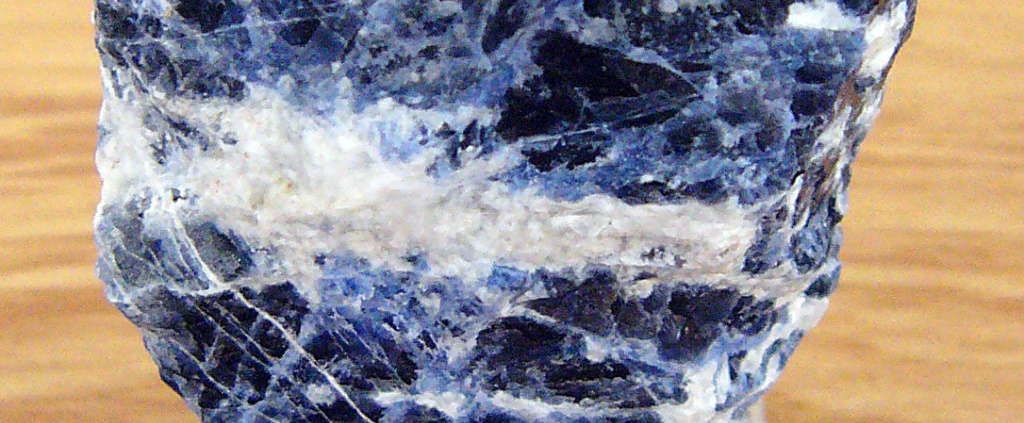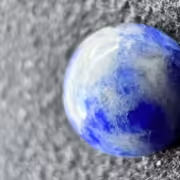Sodalite
 Sodalite crystal blue stone
Sodalite crystal blue stone
 Sodalite crystal
Sodalite crystal
Sodalite is a feldspathoidal tectosilicate mineral that is rich royal blue widely used as an ornamental gemstone. Chemical formula is Na8 (Al6Si6O24) Cl2. Specimens can be blue, gray, pink, colorless, or other pale shades. They sometimes fluoresce bright orange under ultraviolet light. Sodalite nearly always forms massive aggregates or disseminated grains. Crystals are relatively rare; when found, they are dodecahedral or octahedral. Sodalite occurs in igneous rocks and associated pegmatites. It is sometimes found in contact metamorphosed limestones and dolomites and in rocks ejected from volcanoes. Rare crystals are found on the Mount Vesuvius volcano in Italy. Uncommon transparent specimens from Mont St.-Hilaire, Canada, are faceted for collectors. Although massive sodalite samples are opaque, crystals are usually transparent to translucent. Sodalite is a member of the sodalite group with hauyne, nosean, lazurite and tugtupite.
Name: Named in allusion to its sodium content.
Association: Nepheline, cancrinite, titanian andradite, aegirine, microcline, sanidine, albite, calcite, ankerite, barite
Mineral Group: Sodalite group.
Composition: Sodium aluminum silicate with chlorine, Na4Al3Si3- O12CI. Na20 = 25.6 per cent, A120 3 = 31.6 per cent, Si02 = 37.2 per cent, Cl = 7.3 per cent.
Diagnostic Features: Distinguished in most instances by its blue color, and told from lazurite by the absence of associated pyrite. If color is not blue, a positive test for chlorine is the only way to distinguish it from analcime, leucite, and hauynite
Crystallography: Isometric; hextetrahedral. Crystals rare, usually dodecahedrons. Commonly massive, in imbedded grains.
Contents
- Chemical Properties
- Sodalite Physical Properties
- Sodalite Optical Properties
- Occurrence
- Distribution
- References
Chemical Properties
| Chemical Classification | Tectosilicates without zeolitic H2O |
| Formula | Na8(Al6Si6O24)Cl2 |
| Common Impurities | Fe,Mn,K,Ca,H2O,S,Br |
Sodalite Physical Properties
| Color | All Colours |
| Streak | White |
| Luster | Vitreous, Greasy |
| Cleavage | Poor/Indistinct Poor on {110} |
| Diaphaneity | Transparent, Translucent |
| Mohs Hardness | 5,5 – 6 |
| Crystal System | Isometric |
| Tenacity | Brittle |
| Density | 2.27 – 2.33 g/cm3 (Measured) 2.31 g/cm3 (Calculated) |
| Fracture | Sub-Conchoidal |
Sodalite Optical Properties
| Type | Isotropic |
| Color / Pleochroism | Non-pleochroic |
| RI values: | n = 1.483 – 1.487 |
| Twinning | Common on {111} forming pseudohexagonal prisms |
| Birefringence | Isotropic minerals have no birefringence |
| Relief | Moderate |
Occurrence
Occurring typically in massive form, sodalite is found as vein fillings in plutonic igneous rocks such as nepheline syenites. It is associated with other minerals typical of silica-undersaturated environments, namely leucite, cancrinite and natrolite.
Distribution
Widespread; some prominent localities include:
- On the Kangerdluarssuk Plateau and around the Tunugdliark Fjord, in the Ilmaussaq intrusion, southern Greenland.
- From the Langesundsfjord, Norway.
- In the Khibiny and Lovozero massifs, Kola Peninsula, Russia.
- From Monte Somma and Vesuvius, Campania, Italy.
- At the Bellerberg volcano, two km north of Mayen, and elsewhere in the Eifel district, Germany.
- From Litcheld, Kennebec Co., Maine, and at Magnet Cove, Hot Spring Co., Arkansas, USA.
- In Canada, from Bancroft, Ontario; at Mont Saint-Hilaire, Quebec; and along the Ice River, at Kicking Horse Pass, British Columbia.
- From Cerro Sapo, Cochabamba, Bolivia.
References
Bonewitz, R. (2012). Rocks and minerals. 2nd ed. London: DK Publishing.
Dana, J. D. (1864). Manual of Mineralogy… Wiley.
Handbookofmineralogy.org. (2019). Handbook of Mineralogy. [online] Available at: http://www.handbookofmineralogy.org [Accessed 4 Mar. 2019].
Mindat.org. (2019): Mineral information, data and localities.. [online] Available at: https://www.mindat.org/ [Accessed. 2019].




Leave a Reply
Want to join the discussion?Feel free to contribute!